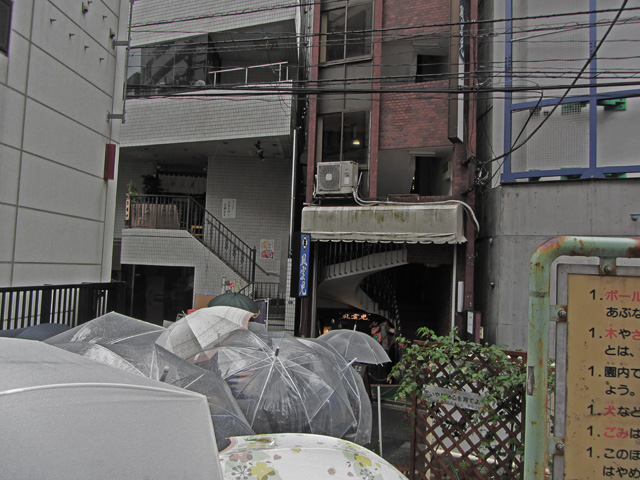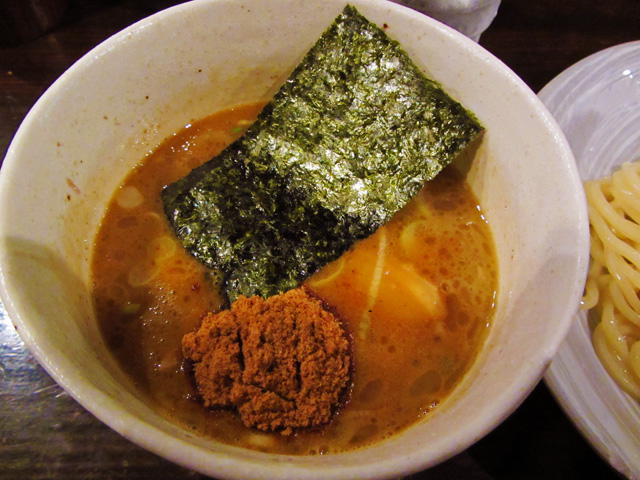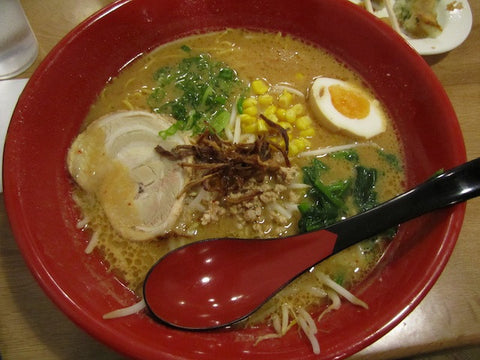
On a dull, drizzling day in Tokyo I set out for my second-ever bowl of
tsukemen (ramen dipping noodles). After its introduction in the early 2000's,
tsukemen has boomed in popularity, rising to a crescendo a few years ago and still going strong. Many, many shops in Tokyo offer both standard ramen and tsukemen, and the consensus is that the majority of the latter tastes relatively similar no matter where it's eaten (although the quality varies). Its varietal evolution has not traveled nearly as far as its much old brother.
My friend
Brian had recommended Fuunji, by his estimation one of the best shops in all of Tokyo. My first and only previous tsukemen experience was very ‘meh' but I knew I had to try it in its hometown.

Fuunji proved to be a popular choice, with 50 or so Tokyoites joining me in the 45 minute line – in the rain. But the way I look at it standing in line for a Tokyo restaurant is essentially a must-try cultural activity.
 The sign tells customers how to form a line on the street as to not block people's way. Like leave gaps so that people can walk freely.
The sign tells customers how to form a line on the street as to not block people's way. Like leave gaps so that people can walk freely.
Part of the allure of tsukemen is that it’s even faster ‘fast food’ than ramen – the broth, by design, is so condensed that it’s not possible to drink on its own, so once you slurp down your noodles you’re out the door. The other part is its homogeny. You pretty much know what to expect at any tsukemen shop, namely a thick, sweet broth (usually pork, although Fuunji – surprisingly – is chicken) mixed with the strong sour tang of
katsuo (dried bonito). Trust me, the first time I read about this I was like “huh?”, but it works.
My first foray into the split soup was at
Ikemen in Hollywood. I wasn't much of a fan, and found that I enjoyed their ramen more than their "Zebra Dip" tsukemen.
Back to Fuunji. I wasn’t sure how to properly eat tsukemen but I had plenty of time to observe the protocol while waiting my turn in line. I saw one guy get his bowl, take a photo, taste a noodle all by itself, then finally start tucking in. I made a mental note to follow this method exactly. The rest of the customers were intense -- very little chatter; everyone was hunched down over their bowl, just slurping away.
And this is the gloriousness they laid down in front of me.

A bowl of the thick chicken broth with a mound of bonito on top, along with a sheet of high quality nori, some negi (green onions) and small chunks of chicken. The noodles were thick and chewy, standard for
tsukemen, and essentially perfect.
It's now eight months later yet I still remember
exactly how Fuunji tasted. I stirred the bonito into the broth, dipped my first grip of noodles, and had an instant revelation; literally my first thought was "Oh, I
get tsukemen now"!

It's like the essence of ramen deconstructed and intensified. The soup is extra thick, way too strong to be sipped alone. The sweetness is super sweet, the sourness super sour. The tangy kick from the bonito is a flavor that simply must be experienced -- I think the thought of dried, ground fish is probably a hard sell to most Americans, but damn, it's the same sort of vinegar-y zest found in great barbecue that keeps you coming back for more. The noodles are super big and the broth clings to them like an insecure boyfriend. It was utterly delicious.
Oishiidesu!
After finishing your noodles you can grab a pot of hot water and add it to the broth, thinning it to the point where you can drink it. I tried it and, while good, it didn't match the punch of the straight broth. So I left after a few sips.
The line out front is no accident. I'd give most anything to be back in Tokyo waiting in it right now instead of sitting at this desk in a Hollywood high rise. It totally reversed my opinion of tsukemen. Since my return to LA I've tried tsukemen at many more LA shops with mixed results (hint:
Tsujita is the best at that too, and I greatly prefer Ikemen’s respectable Ikemen Dip to their Zebra Dip), but it's going to be a long, long time before America has anything close to Fuunji's greatness.
*Will dreams of Tokyo but currently downs his ramen in Los Angeles. When he’s not hunched over a bowl of tonkotsu
or tending his garden you can find him playing shows around town with his band. This post was originally published in The Ramen Shaman.
 On a dull, drizzling day in Tokyo I set out for my second-ever bowl of tsukemen (ramen dipping noodles). After its introduction in the early 2000's, tsukemen has boomed in popularity, rising to a crescendo a few years ago and still going strong. Many, many shops in Tokyo offer both standard ramen and tsukemen, and the consensus is that the majority of the latter tastes relatively similar no matter where it's eaten (although the quality varies). Its varietal evolution has not traveled nearly as far as its much old brother.
My friend Brian had recommended Fuunji, by his estimation one of the best shops in all of Tokyo. My first and only previous tsukemen experience was very ‘meh' but I knew I had to try it in its hometown.
On a dull, drizzling day in Tokyo I set out for my second-ever bowl of tsukemen (ramen dipping noodles). After its introduction in the early 2000's, tsukemen has boomed in popularity, rising to a crescendo a few years ago and still going strong. Many, many shops in Tokyo offer both standard ramen and tsukemen, and the consensus is that the majority of the latter tastes relatively similar no matter where it's eaten (although the quality varies). Its varietal evolution has not traveled nearly as far as its much old brother.
My friend Brian had recommended Fuunji, by his estimation one of the best shops in all of Tokyo. My first and only previous tsukemen experience was very ‘meh' but I knew I had to try it in its hometown.
 Fuunji proved to be a popular choice, with 50 or so Tokyoites joining me in the 45 minute line – in the rain. But the way I look at it standing in line for a Tokyo restaurant is essentially a must-try cultural activity.
Fuunji proved to be a popular choice, with 50 or so Tokyoites joining me in the 45 minute line – in the rain. But the way I look at it standing in line for a Tokyo restaurant is essentially a must-try cultural activity.
 The sign tells customers how to form a line on the street as to not block people's way. Like leave gaps so that people can walk freely.
Part of the allure of tsukemen is that it’s even faster ‘fast food’ than ramen – the broth, by design, is so condensed that it’s not possible to drink on its own, so once you slurp down your noodles you’re out the door. The other part is its homogeny. You pretty much know what to expect at any tsukemen shop, namely a thick, sweet broth (usually pork, although Fuunji – surprisingly – is chicken) mixed with the strong sour tang of katsuo (dried bonito). Trust me, the first time I read about this I was like “huh?”, but it works.
My first foray into the split soup was at Ikemen in Hollywood. I wasn't much of a fan, and found that I enjoyed their ramen more than their "Zebra Dip" tsukemen.
Back to Fuunji. I wasn’t sure how to properly eat tsukemen but I had plenty of time to observe the protocol while waiting my turn in line. I saw one guy get his bowl, take a photo, taste a noodle all by itself, then finally start tucking in. I made a mental note to follow this method exactly. The rest of the customers were intense -- very little chatter; everyone was hunched down over their bowl, just slurping away.
And this is the gloriousness they laid down in front of me.
The sign tells customers how to form a line on the street as to not block people's way. Like leave gaps so that people can walk freely.
Part of the allure of tsukemen is that it’s even faster ‘fast food’ than ramen – the broth, by design, is so condensed that it’s not possible to drink on its own, so once you slurp down your noodles you’re out the door. The other part is its homogeny. You pretty much know what to expect at any tsukemen shop, namely a thick, sweet broth (usually pork, although Fuunji – surprisingly – is chicken) mixed with the strong sour tang of katsuo (dried bonito). Trust me, the first time I read about this I was like “huh?”, but it works.
My first foray into the split soup was at Ikemen in Hollywood. I wasn't much of a fan, and found that I enjoyed their ramen more than their "Zebra Dip" tsukemen.
Back to Fuunji. I wasn’t sure how to properly eat tsukemen but I had plenty of time to observe the protocol while waiting my turn in line. I saw one guy get his bowl, take a photo, taste a noodle all by itself, then finally start tucking in. I made a mental note to follow this method exactly. The rest of the customers were intense -- very little chatter; everyone was hunched down over their bowl, just slurping away.
And this is the gloriousness they laid down in front of me.
 A bowl of the thick chicken broth with a mound of bonito on top, along with a sheet of high quality nori, some negi (green onions) and small chunks of chicken. The noodles were thick and chewy, standard for tsukemen, and essentially perfect.
It's now eight months later yet I still remember exactly how Fuunji tasted. I stirred the bonito into the broth, dipped my first grip of noodles, and had an instant revelation; literally my first thought was "Oh, I get tsukemen now"!
A bowl of the thick chicken broth with a mound of bonito on top, along with a sheet of high quality nori, some negi (green onions) and small chunks of chicken. The noodles were thick and chewy, standard for tsukemen, and essentially perfect.
It's now eight months later yet I still remember exactly how Fuunji tasted. I stirred the bonito into the broth, dipped my first grip of noodles, and had an instant revelation; literally my first thought was "Oh, I get tsukemen now"!
 It's like the essence of ramen deconstructed and intensified. The soup is extra thick, way too strong to be sipped alone. The sweetness is super sweet, the sourness super sour. The tangy kick from the bonito is a flavor that simply must be experienced -- I think the thought of dried, ground fish is probably a hard sell to most Americans, but damn, it's the same sort of vinegar-y zest found in great barbecue that keeps you coming back for more. The noodles are super big and the broth clings to them like an insecure boyfriend. It was utterly delicious. Oishiidesu!
After finishing your noodles you can grab a pot of hot water and add it to the broth, thinning it to the point where you can drink it. I tried it and, while good, it didn't match the punch of the straight broth. So I left after a few sips.
The line out front is no accident. I'd give most anything to be back in Tokyo waiting in it right now instead of sitting at this desk in a Hollywood high rise. It totally reversed my opinion of tsukemen. Since my return to LA I've tried tsukemen at many more LA shops with mixed results (hint: Tsujita is the best at that too, and I greatly prefer Ikemen’s respectable Ikemen Dip to their Zebra Dip), but it's going to be a long, long time before America has anything close to Fuunji's greatness.
*Will dreams of Tokyo but currently downs his ramen in Los Angeles. When he’s not hunched over a bowl of tonkotsu or tending his garden you can find him playing shows around town with his band. This post was originally published in The Ramen Shaman.
It's like the essence of ramen deconstructed and intensified. The soup is extra thick, way too strong to be sipped alone. The sweetness is super sweet, the sourness super sour. The tangy kick from the bonito is a flavor that simply must be experienced -- I think the thought of dried, ground fish is probably a hard sell to most Americans, but damn, it's the same sort of vinegar-y zest found in great barbecue that keeps you coming back for more. The noodles are super big and the broth clings to them like an insecure boyfriend. It was utterly delicious. Oishiidesu!
After finishing your noodles you can grab a pot of hot water and add it to the broth, thinning it to the point where you can drink it. I tried it and, while good, it didn't match the punch of the straight broth. So I left after a few sips.
The line out front is no accident. I'd give most anything to be back in Tokyo waiting in it right now instead of sitting at this desk in a Hollywood high rise. It totally reversed my opinion of tsukemen. Since my return to LA I've tried tsukemen at many more LA shops with mixed results (hint: Tsujita is the best at that too, and I greatly prefer Ikemen’s respectable Ikemen Dip to their Zebra Dip), but it's going to be a long, long time before America has anything close to Fuunji's greatness.
*Will dreams of Tokyo but currently downs his ramen in Los Angeles. When he’s not hunched over a bowl of tonkotsu or tending his garden you can find him playing shows around town with his band. This post was originally published in The Ramen Shaman.




Comments (1)
Thank you for your informative post. Im experimenting with my own Tsukemen ramen at the restaurant. I operate a ramen shop here in Minneapolis, and that will be on the menu for tomorrow! We’ll see how it goes.